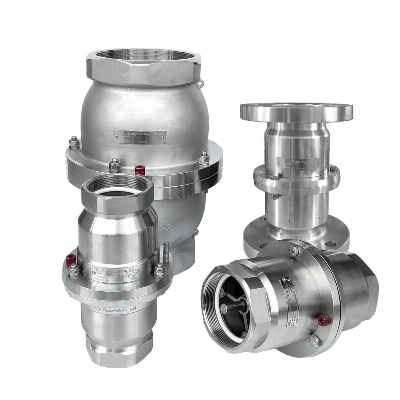DESCRIPTIONSAFETY BREAK-AWAY COUPLINGSPECIFICATIONCoupling
MaterialStainless steel, AluminiumCoupling GasketFPM , EPDM , NBR ,
PTFEThreadNPT, BSPSizeFrom 1" up to 12"ConnectionThread,
FlangeProtection cover can be customizedAPPLICATIONA break-away
coupling is used in various industries and applications to enhance
safety and prevent potential damage or accidents. Here are some
reasons why a break-away coupling might be employed:1. Emergency
Shut-Off: Break-away couplings are designed to disconnect two
connected components or systems in an emergency situation. In case
of an unexpected pull, excessive pressure, or other hazardous
conditions, the coupling automatically separates to prevent further
damage or danger.2. Spill Prevention: Break-away couplings are
commonly used in fluid transfer systems, such as fueling stations,
chemical plants, or oil refineries. If a vehicle or vessel drives
away while still connected to a fuel pump or loading arm, the
break-away coupling disconnects, preventing spillage and
minimizing the risk of fire or environmental pollution.3. Equipment
Protection: Break-away couplings can protect expensive or sensitive
equipment from damage. For instance, in industrial applications
where heavy machinery is involved, if a sudden jolt or pull occurs,
the coupling disconnects to safeguard the machinery, hoses, or
pipes from being damaged.4. Worker Safety: Break-away couplings
prioritize worker safety by reducing the risk of injury. If a
worker accidentally trips or gets entangled in a hose or cable, the
break-away coupling will separate, preventing further harm by
stopping the flow of fluid or preventing dangerous movements.5.
Compatibility and Flexibility: Break-away couplings are available
in different sizes, designs, and materials to accommodate various
applications and fluid types. They can be customized to suit
specific requirements, ensuring compatibility with existing
equipment and systems. Remember that the specific reasons for
using break-away couplings may vary depending on the industry and
application. It is essential to consult industry standards,
guidelines, and specific safety regulations to determine the
appropriate use of break-away couplings for a given scenario.How
does a BREAK-AWAY coupling work?Coupling before emergency
disconnectA break-away coupling consists of two main components: a
male par t and a female part. These parts are securely connected to
different sections of a hose, pipe, or system. The coupling is
designed to hold the two parts together firmly,allowing fluid or
material to flow through.Coupling after emergency disconnectIn the
event of excessive force or sudden movement, the break-away
coupling is designed to separate or disconnect. The separation
occurs at a predetermined break point, which is typically a weaker
section of the coupling intentionally designed to give way under
certain conditions.FEATUREThe mechanism for separation varies
depending on the specific design of the breakaway coupling.
However, some common mechanisms include:1. Break Pins: Break pins
are commonly used in break-away couplings. They are designed to
shear or break when a specific force threshold is exceeded. The
break pins are usually located within the coupling and are aligned
in such a way that they keep the male and female parts together
under normal operating conditions. When a force greater than the
break pin's threshold is applied, the pins break, causing the
coupling to separate.2. Ball Bearings: Some break-away couplings
use ball bearings as a separation mechanism. The male and female
parts of the coupling are connected using a ball-and-socket joint.
Under normal conditions, the ball bearings keep the parts together.
However, when a sufficient force is applied, the ball bearings are
forced out of their sockets, allowing the coupling to separate.3.
Friction Rings: Friction rings are another mechanism employed in
break-away couplings. They use friction to hold the male and female
parts together. When a force is applied that exceeds the frictional
resistance of the rings, they slip against each other, causing the
coupling to separate.ADVANTAGE1. Safety Enhancement: Break-away
couplings significantly improve safety by preventing accidents,
injuries, and property damage. They provide a quick and automatic
disconnection when excessive force or movement occurs, reducing the
risk of spills, leaks, or equipment damage. This helps protect
workers, the environment, and valuable assets..2. Regulatory
Compliance: Break-away couplings help companies meet regulatory
requirements and industry standards. Many industries have specific
safety regulations that mandate the use of break-away couplings in
certain applications. By incorporating these couplings, businesses
demonstrate their commitment to safety and compliance.3. Peace of
Mind: The presence of break-away couplings instills confidence and
peace of mind for operators, workers, and stakeholders. Knowing
that a reliable disconnection m
Related products about FLOWCAN SAFETY BREAKAWAY COUPLING QUICK COUPLING HOSE CONNECTOR
-
 Waste Tyre Plastic Recycling Machinery Machine Tire Crusher Production Line Rubber Crumb Grinding Machine Equipment Tire Shredder
Waste Tyre Plastic Recycling Machinery Machine Tire Crusher Production Line Rubber Crumb Grinding Machine Equipment Tire Shredder
-
 Stretch Plastic Blowing Pet Bottle Making Blow Molding Machine Bottles Stretch Automatic Pet Bottle Blowing Machine
Stretch Plastic Blowing Pet Bottle Making Blow Molding Machine Bottles Stretch Automatic Pet Bottle Blowing Machine
-
 Waste Plastic Pet Bottle, Water Bottle Flake, PP/HDPE/LDPE PE Film Jumbo Woven Bags Plastic Crusher Machine, Plastic Crushing Washing Recycling Machine
Waste Plastic Pet Bottle, Water Bottle Flake, PP/HDPE/LDPE PE Film Jumbo Woven Bags Plastic Crusher Machine, Plastic Crushing Washing Recycling Machine
-
 Type 2 Wall-Mounted Electric Car Charging Station 7kw /11 Kwelectric Vehicle Charging Station Home Wallbox AC EV Charger Single Phase or 3three Phase
Type 2 Wall-Mounted Electric Car Charging Station 7kw /11 Kwelectric Vehicle Charging Station Home Wallbox AC EV Charger Single Phase or 3three Phase
-
 G-View G12W Wholesale Auto Car LED Headlight Bulb High Power H13 H11 9005 H7 H4 Car LED Headlights LED Car Lights
G-View G12W Wholesale Auto Car LED Headlight Bulb High Power H13 H11 9005 H7 H4 Car LED Headlights LED Car Lights
-
 New Design Porcelain Round Plates Dinner Set for Wedding and Banquet
New Design Porcelain Round Plates Dinner Set for Wedding and Banquet
-
 China 2023 New Design Super Soft 100% Polyester Microfiber Knitted Oversized Decoration Hoodie Blanket
China 2023 New Design Super Soft 100% Polyester Microfiber Knitted Oversized Decoration Hoodie Blanket
-
 Handmade Art Creative Materials Thickened White Paper Cup DIY Disposable Handmade Colored Paper Cup
Handmade Art Creative Materials Thickened White Paper Cup DIY Disposable Handmade Colored Paper Cup



